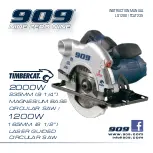
12
GB
14. Electrical connection
The electrical motor installed is connected and
ready for operation. The connection complies with
the applicable VDE and DIN provisions. The custom-
er‘s mains connection as well as the extension ca-
ble used must also comply with these regulations.
14.1 Important information
In the event of an overloading the motor will switch itself
off. After a cool-down period (time varies) the motor can be
switched back on again.
14.2 Damaged electrical connection cable
The insulation on electrical connection cables is often dam-
aged.
This may have the following causes:
• Passage points, where connection cables are passed
through windows or doors.
• Kinks where the connection cable has been improperly fas-
tened or routed.
• Places where the connection cables have been cut due to
being driven over.
• Insulation damage due to being ripped out of the wall outlet.
• Cracks due to the insulation ageing.
Such damaged electrical connection cables must not be used
and are life-threatening due to the insulation damage.
Check the electrical connection cables for damage regularly.
Make sure that the connection cable does not hang on the
power network during the inspection.
Electrical connection cables must comply with the applicable
VDE and DIN provisions. Only use connection cables of the
same designation.
The printing of the type designation on the connection cable
is mandatory.
If the power cord of this device is damaged, it must be replaced
by a special power cord, which is available from the manufac-
turer or its service department.
14.3 AC motor
The mains voltage must be 220 - 240 V~.
• Extension cables up to 25 m long must have a cross-section
of 1.5 mm
2
.
Connections and repairs of electrical equipment may only be
carried out by an electrician.
Please provide the following information in the event of any
enquiries:
• Type of current for the motor
• Machine data - type plate
15. Disposal and recycling
The equipment is supplied in packaging to prevent it from be-
ing damaged in transit. The raw materials in this packaging
can be reused or recycled. The equipment and its accesso-
ries are made of various types of material, such as metal and
plastic. Defective components must be disposed of as special
waste. Ask your dealer or your local council.
The packaging is wholly composed of environment-
ally-friendly materials that can be disposed of at a
local recycling centre.
Contact your local refuse disposal authority for
more details of how to dispose of your worn-out
electrical devices.
Old devices must not be disposed of with house-
hold waste!
This symbol indicates that this product must not be dis-
posed of together with domestic waste in compliance
with the Directive (2012/19/EU) pertaining to waste
electrical and electronic equipment (WEEE). This prod-
uct must be disposed of at a designated collection point. This
can occur, for example, by handing it in at an authorised col-
lecting point for the recycling of waste electrical and elec-
tronic equipment. Improper handling of waste equipment may
have negative consequences for the environment and human
health due to potentially hazardous substances that are often
contained in electrical and electronic equipment. By properly
disposing of this product, you are also contributing to the ef-
fective use of natural resources. You can obtain information
on collection points for waste equipment from your municipal
administration, public waste disposal authority, an authorised
body for the disposal of waste electrical and electronic equip-
ment or your waste disposal company.
Summary of Contents for 360564 2010
Page 5: ...17 30 16 28 29 C 12 33 34 18 31 5 6 20 E 19 32 38 E E 14 15 4 4 7 7 14 14 13 24 24a 25...
Page 93: ......
Page 94: ......
















































